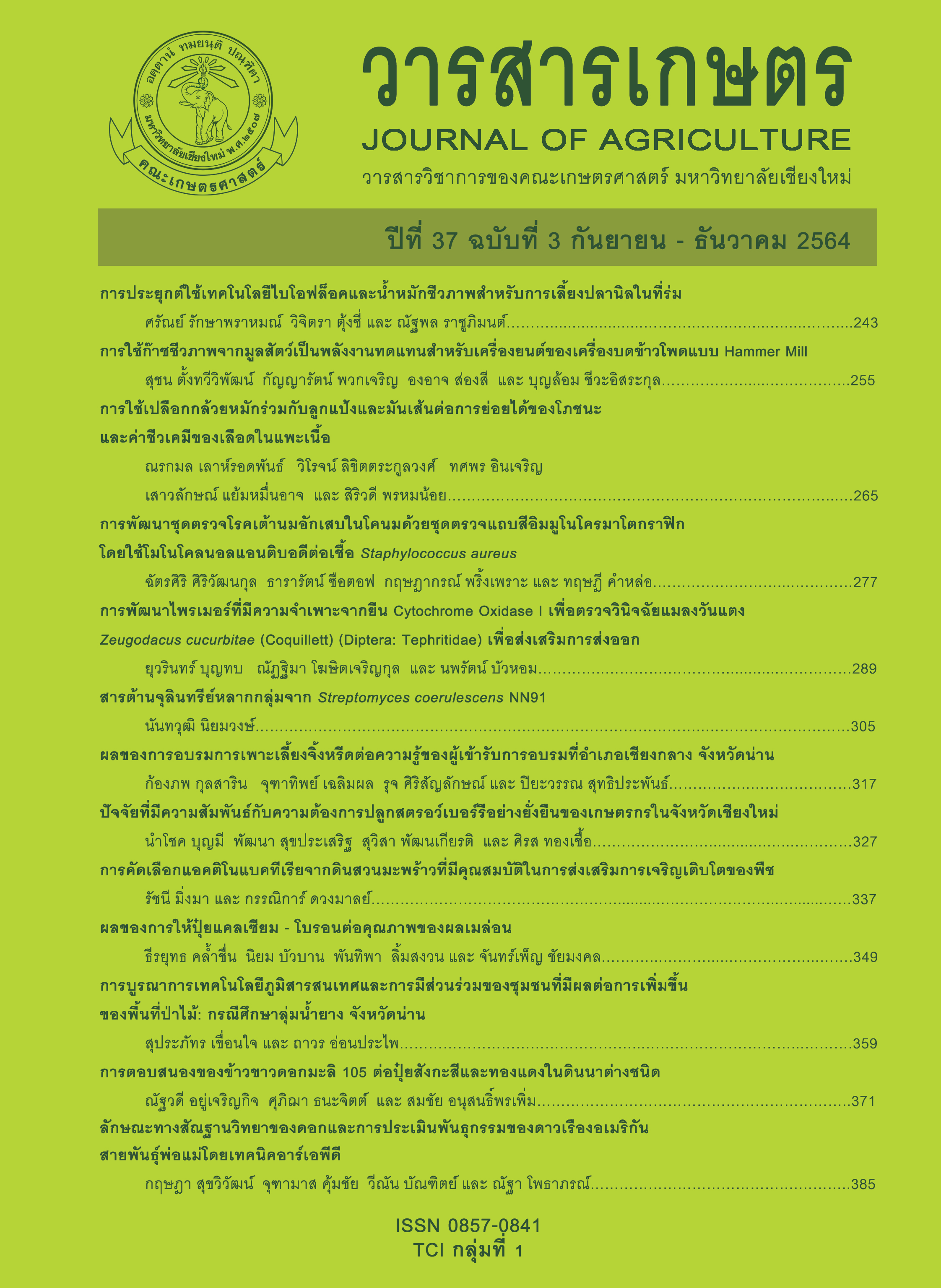Use of Biogas from Animal Feces as a Renewable Energy for Engine of a Corn Hammer Mill
Main Article Content
Abstract
This study aimed to evaluate the efficiency of small corn hammer mill grinder using biogas engine. The preliminary work was carried out at Livestock Research and Development section of Royal Project Foundation. It was found that the biogas which produced from young chicken excreta contained 1,610 ± 26.46 ppm H2S. After passing through the filter, the concentration of H2S was only 2.33 ± 0.58 ppm, which indicated the high efficiency (99.86 %) of the filter. This biogas was used with 6.5 hp engine for corn grinding to pull the hammer mill of 6, 8 and 10 inches diameter. It was found that the 8 inches diameter of hammer mill was more significantly effective in grinding than the 6 and the 10 inches diameter (P < 0.01). It required significantly less biogas and need less cost of grinding (10.473 vs. 17.163 and 38.259 liter / kg of corn grain, and 54.19 vs. 101.11 and 125.60 Baht / 100 kg of corn grain, respectively; P < 0.01). On the contrary, the speed of the 10 inches diameter hammer mill was significantly less than the 6 and the 8 inches diameter. In addition, it required higher amount of biogas than the 8 and the 6 inches diameter (P < 0.01). The machine was then used and the satisfactory of the user was evaluated at the farm in the community of Mae Song Highland Development Project using Royal Project Model, Tak province. Two biogas units with 8 + 8 m3 size were constructed at the farmer house where 25 - 35 heads of fattening and breeding swine were raised. It was found that the biogas can be produced even at the 1,000 m MSL attitude. It can be an alternative energy for hammer mill grinder in highland farm. The satisfaction of the farmers to the developed equipment was 4.76 out of 5 score, which indicated the highly satisfaction.
Article Details
References
Al Mamun, M.R. and S. Torii. 2015. Removal of hydrogen sulfide (H2S) from biogas using zero-valent iron. Journal of Clean Energy Technologies 3(6): 428-432.
Kristoferson, L. A. and V. Bokalders. 1991. Renewable Energy Technologies: Their Applications in Developing Countries. ITDG Publishing, London. 326 p.
Kulkarni, M.B. and P.M. Ghanegaonkar. 2019. Hydrogen sulfide removal from biogas using chemical absorption technique in packed column reactors. Global Journal of Environmental Science and Management 5(1): 155-166.
Landahl, G. 2003. Biogas as Vehicle Fuel: A European Overview. Trendsetter Report No. 2003:3. Stockholm Environment Administration, Stockholm. 51 p.
Persson, M. 2007. Biogas upgrading and utilization as vehicle fuel. pp. 59-64. In: Proceedings of European Biogas Workshop: The Future of Biogas in Europe III, University of Southern Denmark, Esbjerg, Denmark.
Songsee, O. 2012. Production of biogas as a renewable energy source for small farm engines. Final report. Ministry of Science and Technology, Bangkok. 77 p. (in Thai)
Steel, R.G.D., J.H. Torrie and D.A. Dickey. 1997. Principles and Procedures of Statistics: A Biometrical Approach. 3rd ed. McGraw-Hill Book Co. Inc., New York. 666 p.
Tangtaweewipat, S., O. Songsee and B. Cheva-Isarakul. 2012. Diminishing of hydrogen sulfide from biogas for community use. Khon Kaen Agriculture Journal 40 (Suppl. 2): 201-204. (in Thai)
Tangtaweewipat, S., O. Songsee, B. Cheva-Isarakul and K. Puakchareon. 2020. Use of biogas from swine manure as a renewable energy to produce electricity in community of Highland Development Project using the Royal Project Model. Journal of Agriculture 36(3): 365-375. (in Thai)
Tangtaweewipat, S., O. Songsee, B. Cheva-Isarakul, P. Polperm and S. Chaimanee. 2011. Research and development on efficiency of biogas production for small farm holders in highland area. Final report. Highland Research and Development Institute (Public Organization), Chiang Mai. 88 p. (in Thai)
Tangtaweewipat, S., O. Songsee, B. Cheva-Isarakul, K. Puakchareon, W. Thantharak and K. Umetsu. 2019. Use of biogas as a renewable energy source for producing electricity on highland area. Khon Kaen Agriculture Journal 47 (Suppl. 2): 397-404. (in Thai)


